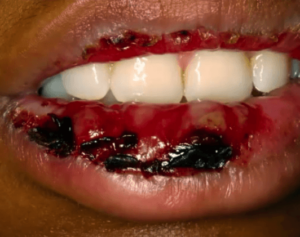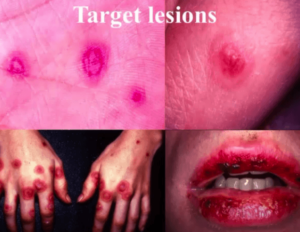Erythema multiforme is a mucocutaneous condition that can cause lesions of the mucous membranes and the skin. Here is how to diagnose and treat Erythema Multiforme and the EM-TEN Spectrum.
Don’t have time to read this article? We get it. Download the Diagnosing Vesicular Ulcerative Conditions checklist to get the key information and images from this article plus all the other conditions we cover in the Dentist’s Guide to Oral Pathology.

Erythema Multiforme Pictures

Here we have a clinical picture where you wouldn’t see vesicles or bullae, but you do see diffuse ulcerations involving the lips and the tongue.
There’s not a lot of things that come to my mind. One of them is Erythema Multiforme and the other one would be pemphigus vulgaris of paraneoplastic pemphigus which can have diffuse lip involvement. If it was paraneoplastic pemphigus then it would have diffuse involvement everywhere.
Erythema Multiforme causes lesions of the mucous membranes and the skin. This is autoimmune but it’s thought to be more of a hypersensitivity-type reaction or immune complex condition. It’s not the same etiology as the other vesiculobullous conditions we talked about like mucous membrane pemphigoid.

Here’s another good example. You’re always going to see diffuse lip involvement, crusted lesions, ulcerative lesions of the lips. It gives the overall impression of an ulcer infection in the mouth.
This is a rapid onset so patients will go to bed and then wake up with this. Obviously, it is very alarming so that’s something that is very helpful in the clinical picture.When you’re taking information, that would be supportive of Erythema Multiforme.

Another thing that’s really important is to look for skin lesions on these patients. These patients will have what we call target lesions or target-wide lesions oftentimes on their hands, feet and their palmar or plantar surfaces. Not a lot of rashes will present there. Another type of rash that will present there is a rash of syphilis.
Here you see pretty diffuse involvement of these target white lesions, crusted lips, and the patients may or may not you know the etiology is different things that may be related to medication. If it’s recurrent it is oftentimes secondary to herpes reactivation and as the body’s response to herpes reactivation.

Erythema Multiforme of the Oral Mucosa
So you can have not only lip involvement but other areas in the oral mucosa can be involved.
Here we have pretty diffuse involvement of the buccal mucosa. You see ulcerative lesions, targeted lesions even in the oral cavity, and then some pseudomembrane formation.
How to Diagnose Erythema Multiforme
- blood-crusted lips
- targeted/bulls-eye skin lesions
- it may be cyclic or periodic, with a very rapid onset.
Erythema Multiforme Treatment Guidelines
These patients are treated with steroids to decrease their immune systems just basically a hyperactivity. If it’s recurrent patients will often be placed on prophylactic Valtrex or prophylactic antivirals because sometimes it is secondary to reactivation of the herpes virus.
- Systemic steroids
- Recurrent: Valtrex 500mg. once/day
What is the Erythema Multiforme Spectrum?
So just talking quickly about the Erythema Multiforme, Steven-Johnson Syndrome and Toxic Epidermal Necrolysis spectrum.
Steven-Johnson Syndrome
There’s a spectrum of conditions that range from less severe, the localized Erythema Multiforme, and then the middle condition is called Steven Johnson syndrome. Erythema Multiforme is limited to the lips and some target lesions. Steven-Johnson Syndrome is an atypical confluent of skin lesions with severe mucosal erosions involving less than 10% of body surface. Steven Johnson Syndrome is associated with a 5% mortality rate.
Toxic Epidermal Necrolysis
The opposite, most involved end of the spectrum is Toxic Epidermal Necrolysis when you have lesions involving more than 30% of the body surface with severe mucosal ulcerations. Here you see a higher mortality rate of about 30%.
There is an area between 10 and 30% that is kind of an overlap syndrome. It doesn’t always fit nicely, but that you know it is the EM-TEN spectrum.
Vesicular Ulcerative Conditions
Download the Diagnosing Vesicular Ulcerative Conditions checklist to get all the key information and images from this article.

Postgraduate Oral Pathology and Radiology Certificate
Learn more about the clinical and didactic skills necessary to evaluate and manage patients with oral diseases by enrolling in Herman Ostrow School of USC’s online, competency-based certificate program in Oral Pathology and Radiology.

